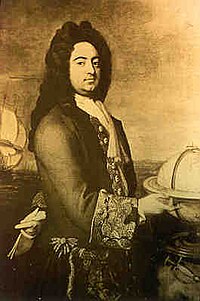
Back حصار بورت رويال (1710) Arabic Sitio de Port Royal Spanish Siège de Port-Royal (1710) French Assedio di Port Royal (1710) Italian ポートロワイヤルの戦い (1710年) Japanese Omleiringa av Port Royal i 1710 NN Beleiringen av Port Royal i 1710 NB Cerco de Port Royal (1710) Portuguese
| Siege of Port Royal | |||||||
|---|---|---|---|---|---|---|---|
| Part of Queen Anne's War | |||||||
 Portrait believed to be of Francis Nicholson, by Michael Dahl, c. 1710 | |||||||
| |||||||
| Belligerents | |||||||
| Commanders and leaders | |||||||
|
Francis Nicholson Samuel Vetch |
Daniel d'Auger de Subercase Simon-Pierre Denys de Bonaventure | ||||||
| Strength | |||||||
| About 2,000 regular and provincial soldiers[2][3] | Fewer than 300[2] | ||||||
| Casualties and losses | |||||||
| Unknown | Unknown | ||||||
| Part of a series on the |
| Military history of Nova Scotia |
|---|
 |
The siege of Port Royal (5–13 October 1710),[n 1] also known as the Conquest of Acadia,[4] was a military siege conducted by British regular and provincial forces under the command of Francis Nicholson against a French Acadian garrison and the Wabanaki Confederacy[5] under the command of Daniel d'Auger de Subercase, at the Acadian capital, Port Royal. The successful British siege marked the beginning of permanent British control over the peninsular portion of Acadia, which they renamed Nova Scotia, and it was the first time the British took and held a French colonial possession.[n 2] After the French surrender, the British occupied the fort in the capital with all the pomp and ceremony of having captured one of the great fortresses of Europe,[6] and renamed it Annapolis Royal.
The siege was the third British attempt during Queen Anne's War to capture the Acadian capital, and it had profound consequences over the next 50 years. The conquest was a key element in the framing of the North American issues in French-British treaty negotiations of 1711–1713. It resulted in the creation of a new colony—Nova Scotia—and introduced significant questions concerning the fate of both the Acadians and the Mi'kmaq[n 3] who continued to occupy Acadia.[7]
The Conquest of Acadia was a foundational moment in the history of the Canadian state—it was a precursor to the British conquests of Louisbourg and Quebec in the middle of the century.[8]
- ^ Cite error: The named reference
P84was invoked but never defined (see the help page). - ^ a b Griffiths (2005), p. 234.
- ^ Cite error: The named reference
Dra259was invoked but never defined (see the help page). - ^ Reid, John G.; Basque, Maurice; Mancke, Elizabeth; et al. (2004). The "Conquest" of Acadia, 1710: Imperial, Colonial, and Aboriginal Constructions. University of Toronto Press. ISBN 978-0-8020-8538-2.
- ^ Prins, Harald E.L. (1996). The Mi'kmaq: Resistance, Accommodation, and Cultural Survival. Fort Worth: Harcourt Brace. ISBN 0-03-053427-5.
- ^ Grenier (2008), p. 15.
- ^ Prins, pp. 1–2; Reid et al, p. x
- ^ McKay, Ian and Bates, Robin. In the Province of History: The Making of the Public Past in Twentieth-Century Nova Scotia. McGill-Queen's University Press. 2010. p. 78.
Cite error: There are <ref group=n> tags on this page, but the references will not show without a {{reflist|group=n}} template (see the help page).